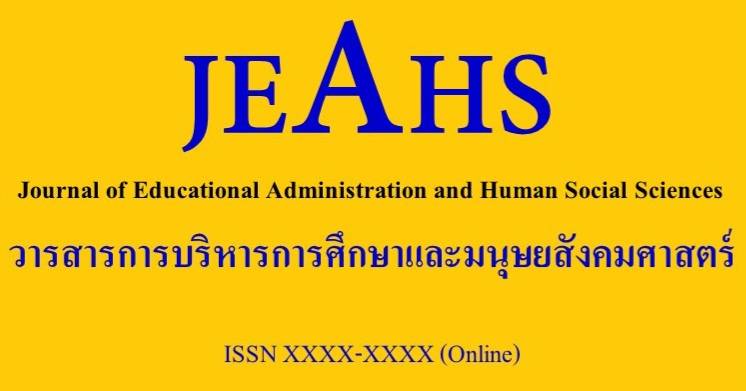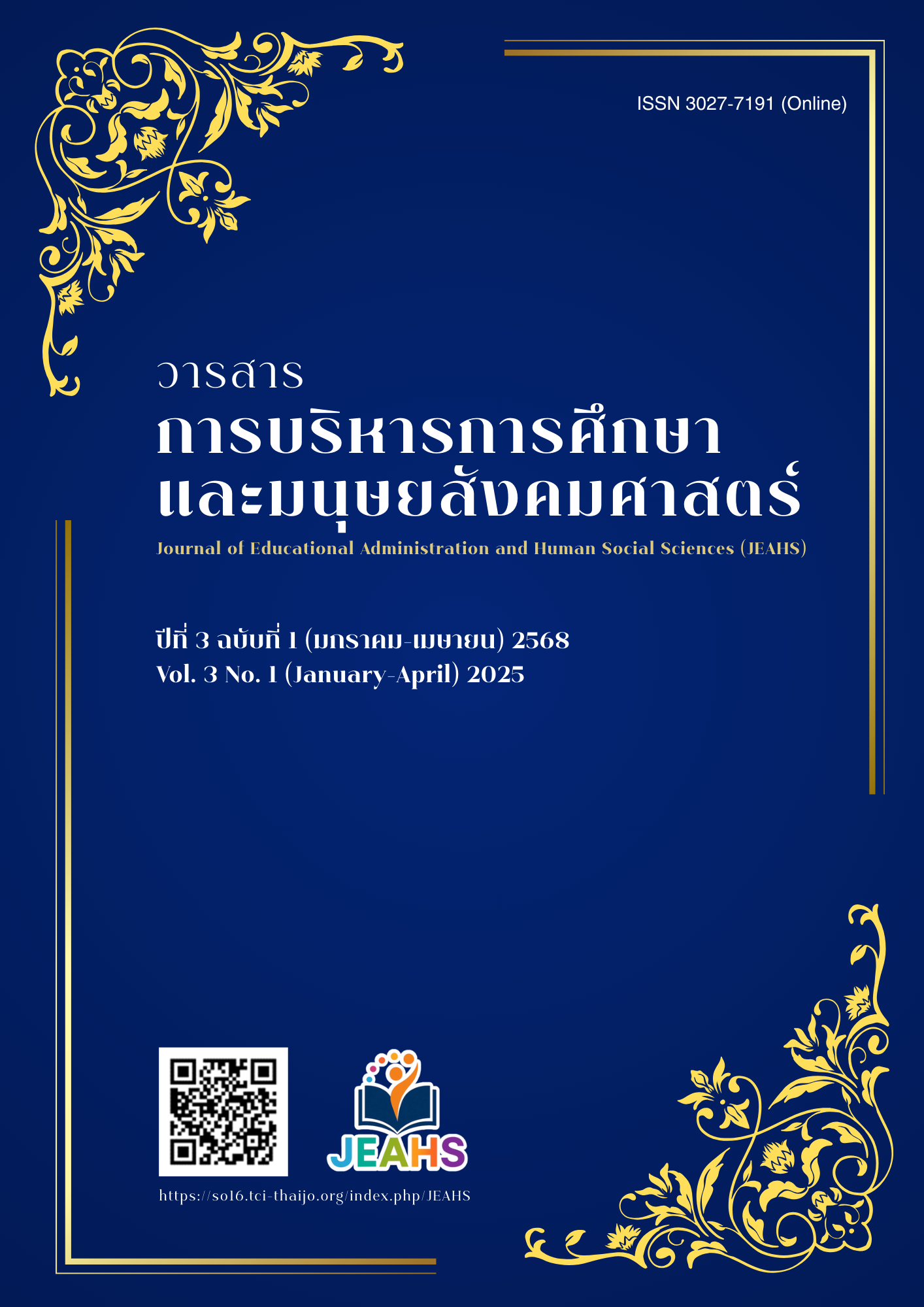พลังแห่งการพัฒนาสู่สถานศึกษาแห่งความสุข
Main Article Content
บทคัดย่อ
ผู้บริหารสถานศึกษามีบทบาทสำคัญในการสร้างบรรยากาศที่กระตุ้นการเรียนรู้และการพัฒนาทั้งด้านการเรียนรู้และการพัฒนาบุคลิกภาพของนักเรียน การเรียนรู้และการพัฒนาบุคลิกภาพของนักเรียน เป็นปัจจัยสำคัญที่ทำให้องค์การเกิดผลลัพธ์แห่งความสำเร็จได้ ผู้บริหารสถานศึกษาเป็นผู้นำในการสร้างสถานศึกษาแห่งความสุข โดยใช้ “Well-Being Leader” เพื่อสร้างบรรยากาศที่เต็มไปด้วยความสุขและความเชื่อมั่นในระยะยาวให้กับนักเรียนและบุคลากร ที่ดำเนินงานในสถานศึกษา การสร้างความสุขในองค์การนั้นสำคัญมาก เพราะ “คน” เป็นทรัพยากรมนุษย์ที่มีชีวิตและจิตใจ รวมทั้งยังเป็นตัวแปรสำคัญที่ทำให้องค์การเกิดผลลัพธ์แห่งความสำเร็จได้ ผู้บริหารสถานศึกษาสร้างสุขด้วยกระบวนการ ป้องเสี่ยงสร้าง “สุข” จึงเป็นการปรับโครงสร้างองค์การให้มีชีวิต เน้นการทำงานเป็นทีม การมีส่วนร่วมของเครือข่ายทั้งภายในและภายนอก เพื่อสร้างห้องเรียนแห่งความสุขที่แท้จริง และยังส่งผลให้สถานศึกษาเป็นเสมือนบ้านหลังแรกและหลังที่สองสำหรับนักเรียนบางคน โดยการเติมเต็มความสุขที่ตกหล่นด้วย “Safe Zone” ทั้งด้านของความปลอดภัยในสถานศึกษา และด้านจิตใจของนักเรียน เพื่อทำให้พวกเขาเติบโตตามศักยภาพในเส้นทางของตนเองต่อไป การเปลี่ยนแปลงโครงสร้างขององค์การเป็นเรื่องสำคัญ เนื่องจากการจะทำให้เกิดความสำเร็จได้นั้น ผู้บริหารสถานศึกษาจำเป็นในการสร้างบรรยากาศแห่งความสุขในการกระตุ้นการเรียนรู้และการพัฒนาแก่บุคลากรของตนเอง เพื่อให้ “สุข” เป็นส่วนหนึ่งของวัตถุประสงค์องค์การ การสร้าง “สถานศึกษาแห่งความสุข” ไม่เพียงแต่มอบความรู้และทักษะเท่านั้น แต่ยังเป็นการสร้างพื้นที่ที่เต็มไปด้วยความเชื่อมั่นและความร่วมมือ การใช้ “Trust Model” เพื่อสร้างความเชื่อมั่นในบุคลากร กระบวนการ สถานศึกษา และเครือข่ายเป็นสิ่งสำคัญอย่างยิ่งที่ทำให้เกิดการเรียนรู้และการพัฒนาที่ยั่งยืน และเกิดความสุขที่แท้จริง
Article Details

อนุญาตภายใต้เงื่อนไข Creative Commons Attribution-NonCommercial-NoDerivatives 4.0 International License.
บทความที่ส่งมาขอรับการตีพิมพ์ในวารสารวารสารการบริหารการศึกษาและมนุษยสังคมศาสตร์ จะต้องไม่เคยตีพิมพ์หรืออยู่ระหว่างการพิจารณาจากผู้ทรงคุณวุฒิเพื่อตีพิมพ์ในวารสารอื่น รวมทั้งผู้เขียนจะต้องคำนึงถึงจริยธรรมการวิจัย ไม่ละเมิดหรือคัดลอกผลงานของผู้อื่นมาเป็นของตนเอง ซึ่งทางวารสารได้กำหนดความซ้ำของผลงานด้วยโปรแกรม CopyCat เว็บ Thaijo ในระดับ ไม่เกิน 25%
ในกรณีที่ บทความวิจัยมีกระบวนการวิจัยเกี่ยวข้องกับมนุษย์ ผู้นิพนธ์จะต้องส่งหลักฐานการรับรองจริยธรรมการวิจัยในมนุษย์มาประกอบการลงตีพิมพ์ด้วยจึงจะได้รับการพิจารณาลงตีพิมพ์ในวารสาร
ผู้เขียนบทความจะต้องปฏิบัติตามหลักเกณฑ์การเสนอบทความเพื่อตีพิมพ์ในวารสารการบริหารการศึกษาและมนุษยสังคมศาสตร์ รวมทั้งระบบการอ้างอิงต้องเป็นไปตามหลักเกณฑ์ของวารสารการบริหารการศึกษาและมนุษยสังคมศาสตร์ โดยรวมทั้งทัศนะและความคิดเห็นที่ปรากฏในบทความในวารสารการบริหารการศึกษาและมนุษยสังคมศาสตร์ ถือเป็นความรับผิดชอบของผู้เขียนบทความนั้น และไม่ถือเป็นทัศนะและความรับผิดชอบของกองบรรณาธิการวารสารการบริหารการศึกษาและมนุษยสังคมศาสตร์ และวารสารการบริหารการศึกษาและมนุษยสังคมศาสตร์
เอกสารอ้างอิง
กริช ธีรางศุ. (2563). แนวทางการพัฒนาเครือข่ายความร่วมมือ สำหรับสถานศึกษาสังกัดสำนักงานเขตพื้นที่การศึกษามัธยมศึกษาเขต 24 กาฬสินธุ์. วิทยานิพนธ์การศึกษามหาบัณฑิต. มหาวิทยาลัยมหาสารคาม.
กองบริหารข้อมูลตลาดแรงงาน กรมการจัดหางาน. (2565). การจัดการความรู้ (Knowledge Management: KM) กระบวนการระดมความรู้/ความคิดเห็นจากภาคีเครือข่าย. แหล่งที่มา https://www.doe.go.th/prd/assets/upload/files/lmia_th/eedb80d6ae79bf0632be4546c3ce41a0.pdf สืบค้นเมื่อ 10 สิงหาคม 2568.
ฐณรินทร์ หวายฤทธิ์ธนกุล. (2566). ให้อิสระโรงเรียนพัฒนาตนเองด้วยแนวทางต่างกัน เพื่อการจัดการศึกษาที่หลากหลาย. แหล่งที่มา https://www.eef.or.th/article-050723/ สืบค้นเมื่อ 10 สิงหาคม 2568.
ทีมงาน EDUCA. (2563). 4 สิ่งที่ผู้บริหารโรงเรียนควรทำ (และไม่ควรทำ) ในการสร้างความสัมพันธ์อันดีกับครูในโรงเรียน. แหล่งที่มา https://www.educathai.com/knowledge/articles/64 สืบค้นเมื่อ 10 สิงหาคม 2568.
ธนารัฐ ฉ่ำสุริยา. (2561). ผู้นำทีมงานกับการสร้างประสิทธิผลขององค์กร. วารสารเครือข่ายส่งเสริมการวิจัยทางมนุษยศาสตร์และสังคมศาสตร์, 1,(3), 16.
นวพัฒน์ อนันตศิลากุล.(2563). ปัจจัยจากทฤษฎีโดมิโนที่มีอิทธิพลต่อระดับความรุนแรงจากการเกิดอุบัติเหตุของพนักงานโรงงานผลิตกระจกแห่งหนึ่งในจังหวัดสมุทรปราการ. วิทยานิพนธ์บริหารธุรกิจมหาบัณฑิต. มหาวิทยาลัยศรีนครินทรวิโรฒ
ปฏิกานต์ พังยะ. (2566).กลยุทธ์การบริหารสถานศึกษาปลอดภัยของโรงเรียนแกน้อยศึกษา สำนักงานเขตพื้นที่การศึกษาประถมศึกษาเชียงใหม่ เขต 3. วิทยานิพนธ์ครุศาสตรมหาบัณฑิต. มหาวิทยาลัยเชียงราย.
พระมหาประยูร ธีรวโร. (2565). วิสัยทัศน์ของผู้บริหารสถานศึกษาสู่ความเป็นเลิศ. วารสารบวรสหการศึกษาและมนุษยสังคมศาสตร์, 3(1), 33.
ศิริรัตน์ วงศ์คำจันทร์. (2566). ทักษะการสื่อสารในศตวรรษที่ 21 ของผู้บริหารสถานศึกษาสังกัดสำนักงานเขตพื้นที่การศึกษาประถมศึกษานนทบุรี เขต 2. วารสาร มจร อุบลปริทรรศน์, 8(3). 827.
สวินทร์ พงษ์เก่า. (2563). การพัฒนากฎความปลอดภัยและการนำไปสู่การปฏิบัติ Safety Rules. แหล่งที่มา http://shawpat.or.th/index.php?option=com_ content&view=article&id=1211:-safety-rules&catid=67:-m-m-s&Itemid=207.สืบค้นเมื่อ 4 กรกฎาคม 2568.
สายชน แพงมา. (2565). การปฏิบัติตนเป็นแบบอย่างที่ดีของผู้บริหารสถานศึกษาสังกัดสำนักงานเขตพื้นที่การศึกษาประถมศึกษาศรีสะเกษ เขต 3. วารสารวิชาการมหาวิทยาลัยราชภัฏศรีสะเกษ, 15(2), 124.
สาวิตรี ยอยยิ้ม. (2560). ภาวะผู้นำกับการสร้างแรงจูงใจเพื่อความสำเร็จในการพัฒนาองค์การ. วารสารบริหารธุรกิจศรีนครินทรวิโรฒ, 8(1). 143.
สำนักงานคณะกรรมการการศึกษาขั้นพื้นฐานกระทรวงศึกษาธิการ.(2565). นโยบายการศึกษา 2567. แหล่งที่มา https://www.chan1.net/story/1270 สืบค้นเมื่อ 12 สิงหาคม 2568.
สุชีรา ใจหวัง และ จันทรรัศม์ ภูติอริยวัฒน์. (2561).การจัดการศึกษาความปลอดภัยในสถานศึกษา สังกัดสำนักงานเขตพื้นที่การศึกษามัธยมศึกษา เขต 1. วารสารบริหารการศึกษา มศว, 15(28), 50-61.
สุเวช พิมน้ำเย็น. (2560). การประเมินการจัดสภาพแวดล้อมและการจัดบริการด้านความปลอดภัยในโรงเรียนสันติคีรีวิทยาคม อำเภอแม่ฟ้าหลวง จังหวัดเชียงราย. สมาคมสถาบันอุดมศึกษาเอกชนแห่งประเทศไทยในพระราชูปถัมภ์สมเด็จพระเทพรัตนราชสุดาฯ สยามบรมราชกุมาร, 6(2), 25-31.


